
CPR
- RMS Empress of
Page
Two - Her Final Voyage
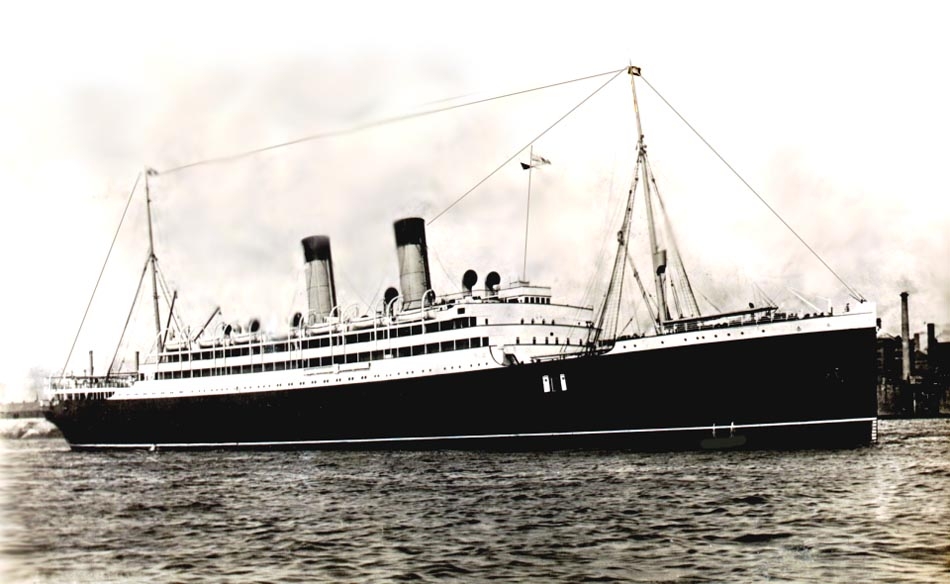
Over the past seven years of the RMS Empress of
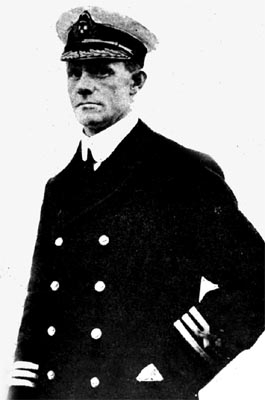 much the basics
for those who travelled on an economy or as migrants to
much the basics
for those who travelled on an economy or as migrants to
In May 1914 the Empress of Ireland returned to
Living in
Captain
Henry George Kendall-
However, Captain Henry George Kendall
recognized the fugitives and just prior steaming out of range of
his ship-board transmitter, he had Radio Man, Lawrence Ernest
Hughes send off a wireless telegram to the British authorities,
which stated: “Have strong suspicions that Crippen London
cellar murderer and accomplice are among saloon passengers.”
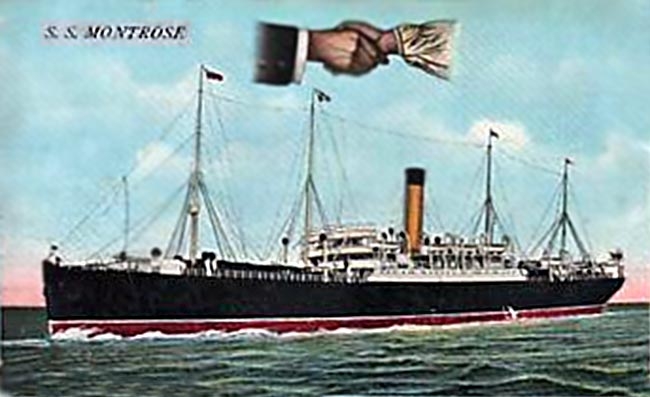
6,278
GRT - She was fitted out for 70 Second-Class and 1,800
Third-Class passengers
For the full story on the murderous Dr. Crippen click the link!
However, as the RMS Empress of
In addition the ship was divided into 11 sections by sealed watertight bulkheads. When these were closed, twenty-four doors used for general ship purposes in the bulkheads made each section completely watertight. Nevertheless, the Empress could float with any two compartments flooded. However, these doors required manual closing.
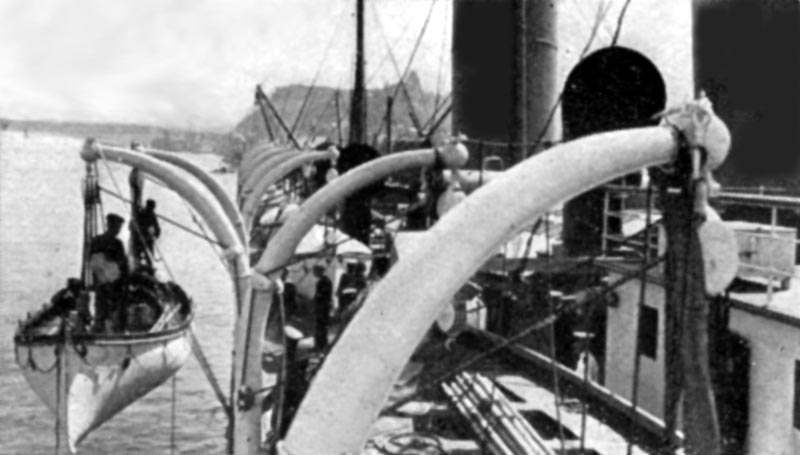
The
crew undertakes one the regular drills and lowers various
lifeboats into the water
There is one other ship I believe I must cover for she plays a very big part in this story and that is the collier SS Storstad, a ship of 6,028 GRT constructed by Messrs Armstrong, Whitworth and Company Limited at Newcastle-on-Tyne in 1910. She was 439.6ft - 134m in length, 58.1ft - 17.7m at the beam and had a Draught of 28.8ft - 8.73m.
Her hull was painted black, and on each side of
the tall amidships located black-painted funnel was a large white
“K",” signifying her ownership by the Norwegian
“Klavenes Line.” The vessel was fitted with 2 stockless
anchors in cast-iron hawsepipes; the anchor flukes projected
18inches from the sides of the ship.
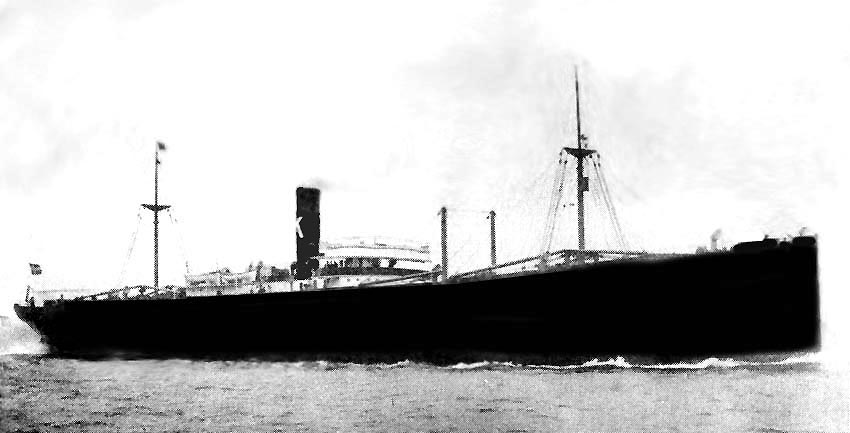
The Storstad was without a doubt the worst
imaginable ship to collide into any ship, let alone amidships
into a boiler room deep under water. The reason being is that her
longitudinal bracing was designed to break through ice, for she
would spend a great deal of her time slicing through ice in the
Northern Hemisphere! This made the Storstad a lethal weapon for
she was life a sharp knife and would cut through plate steel like
butter, in addition considering that she was usually fully loaded
with around 10 to 11-000-tons of coal made her an even more
dangerous weapon, should two ships meet by accident!
RMS Empress of
Amongst the 1,057 passengers there were a good
number of people that were of Irish descent and they were well
represented in all three classes. Irish names, surnames and
backgrounds were well represented in the list of crewmembers,
such as; stewards, seamen, firemen, trimmers and others. Among
the 87 passengers in First Class was a well known actor Laurence
Irving and his wife Mabel.
Among the 87 passengers in First Class was a
well known actor Laurence Irving who had was saved at the sinking
of the ship, but he then drowned as he dived back into the river
in order to locate his beloved wife Mabel. Sadly their bodies
were ever found.
Interestingly, much of Third Class was made up of workers from Ford in Detroit who had been laid-off and were now returning home to Europe, along with many other immigrants who were not able to make in the America’s or Canada. But out of the 717 Third Class passengers only 133 were saved.
As she headed down the
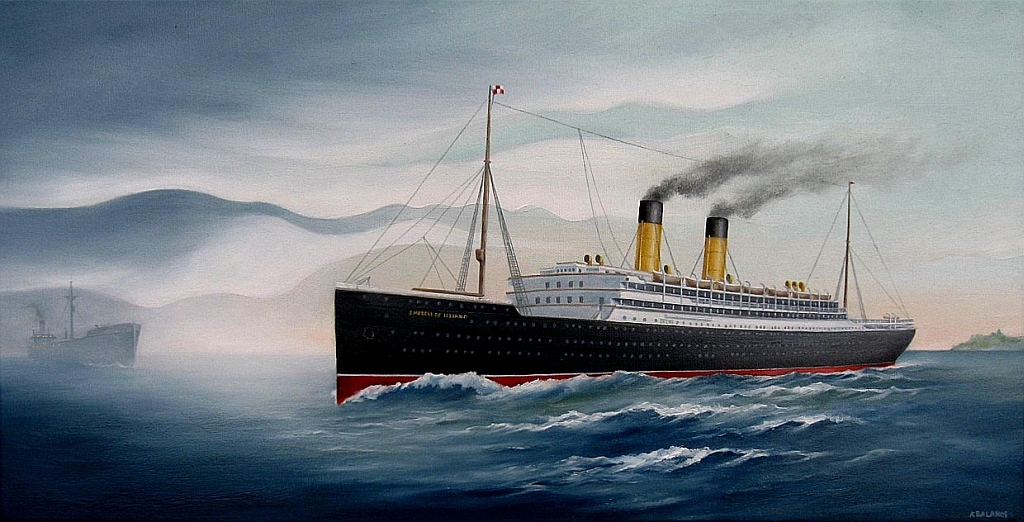
The
Empress meets a wayward collier ice breaker
This
fine work is by & © artist Aristides Balanos
As the great liner continued down the St.
Lawrence it was early the next morning, on May 29, however, a
dense fog engulfed her near
The Captain ordered the Empress full astern and
gave three blasts on its powerful whistle, indicating he was
reversing. Then he stopped the ship and gave two more blasts,
thus informing the oncoming vessel that she was now dead in the
water.
At 1:55 A.M. Captain Kendall was
horrified to see the SS Storstad appearing out of the fog and it
was heading directly for the Empress of Ireland. He acted quickly
and ordered full speed ahead, but sadly it was too late as the
collier inflicted a mortal wound to the starboard side of the
Empress amidships directly into her aft boiler room.

The vast amounts of water was aided by the third class cabin portholes having been left open down on lower deck, although illegally, but passengers desired fresh night air. Thus, most of the passengers and crew on the lower decks drowned almost immediately. Within three minutes of the collision, the raging waters reached the dynamos and knocked out all power, plunging frightened passengers and crew into darkness. although Captain Kendall had ordered lifeboats to be lowered and Marconi wireless operators Edward Bamford and Ronald Ferguson to send out an SOS. Passengers who were on the upper decks and who were able scrambled out on deck, in their night clothes, and some jumped into the frigid waters in a desperate attempt to save themselves, but sadly many more remained trapped below. There were those who were more fortunate who managed to get into one of the five lifeboats that were loaded immediately and took them away from the ship.
Moments later, however, the Empress was tilting
well over on her side that it became impossible to launch any of
the remaining 11 main lifeboats she had onboard. Most of the
people clinging to the deck thought the Empress had run aground.
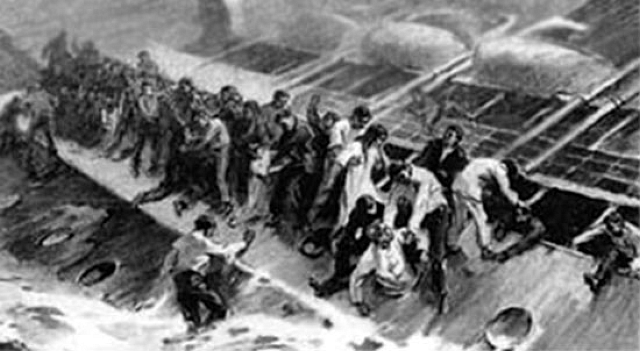
thrown
off when she feel flat on her side or others who sadly drowned in
the river
It was ten minutes after the collision with the Storstad that the Empress of Ireland suddenly lurched violently and she fell flat on her side that those who were still on board or climbing down her sloping side of her hull were all flung off her. This included Captain Kendall who was thrown from the Bridge into the river by the force of the ships fall.
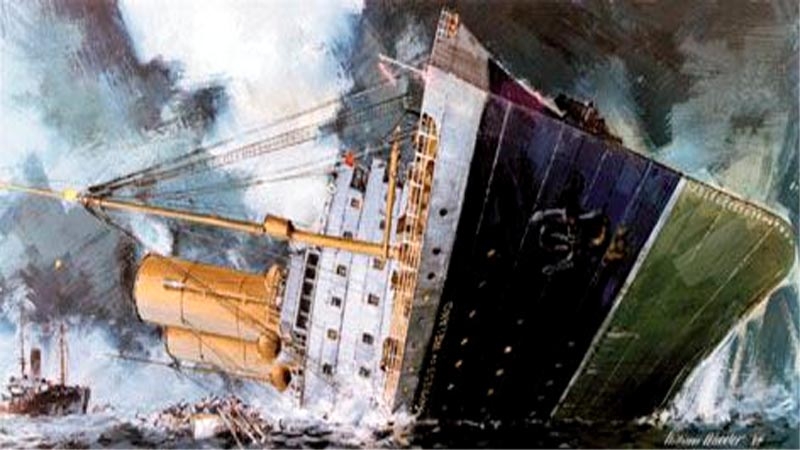
As we already know that among the 87 First
Class passengers Laurence Irving and his wife was travelling
together to
But now came the time to rescue those who were in the water and in lifeboats. Many were rescued by the crew of the Storstad and by ships in the area, including the SS Lady Evelyn. But the sad truth came after morning broke and a final count of the passengers were done, out of 1,057 passengers on board just 217, or a miserable 20.5% were saved. On the other hand, from 420 crewmembers on board, amazingly 248 or a shocking 59% were saved and that is a disgrace. How come that not more was done by the crew to save those they were responsible fore, as that was their duty! But greatest shock of all is the following tragedy; 138 happy children embarked the ship, yet why is it that just 4 or 2.9% survived. A little further down is a chart showing the sad number and all the percentages.
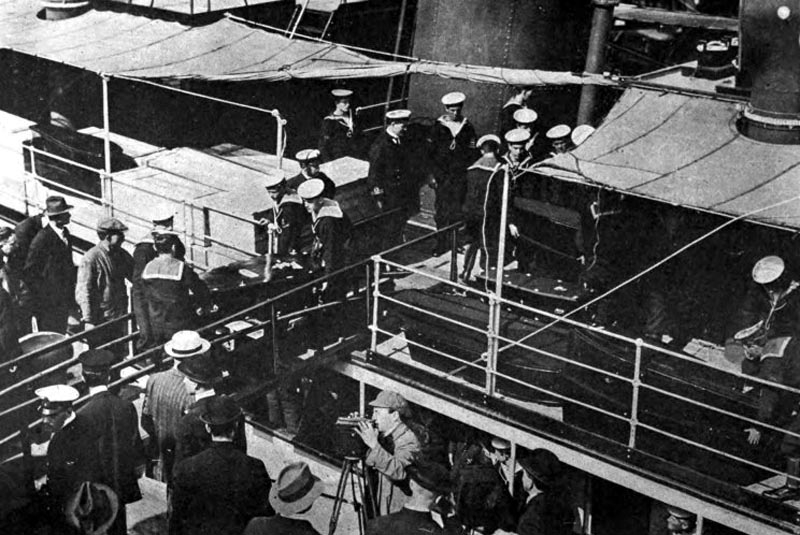
Coffins
of the victims of the Empress removed at
It needs to be clearly understood that each of
these horrific events were great and personal tragedies for
everyone involved, and therefore I am certainly not making small
of the Titanic or Lusitania for both had enormous consequences!
But, this much smaller Trans-Atlantic two stacker had a Lloyd’s of London safety rating of “100-A1,” and yet this horrific and great tragedy that has lost more passengers than the other two liners mentioned, has largely been forgotten within the maritime world, for it is true that everyone seem to be fascinated by that name … “Titanic.” And I am sorry, I find that just tragic. Even the Commission of Inquiry did come to a conclusion of guilt to the Norwegian ship, but it did not seem to take the matter as being very important for bigger matters were at hand globally!
|
Numbers
on board |
Numbers
lost |
Percentage
lost by total onboard |
Numbers
saved |
Percentage
saved by total onboard |
Percentage
survival rate per group |
Crew |
420 |
172 |
11.6% |
248 |
16.8% |
59% |
Passengers |
1,057 |
840 |
56.9% |
217 |
14.7% |
20.5% |
Total |
1,477 |
1,012 |
68.5% |
465 |
31.5% |
- |
1st
Class Passengers |
87 |
51 |
3.4% |
36 |
2.4% |
41.3% |
2nd
Class Passengers |
253 |
205 |
13.9% |
48 |
3.24% |
18.9% |
3rd
Class/ Steerage Passengers |
584 |
39.5% |
133 |
9% |
18.5% |
|
Children |
138 |
134 |
9.07% |
4 |
0.3% |
2.9% |
Women |
310 |
269 |
18.2% |
41 |
2.8% |
13.2% |
Men |
609 |
437 |
29.6% |
172 |
11.6% |
28.2% |
Convened on June 16, 1914 the Commission of
Inquiry, chaired by Lord Mersey who had also presided over the
hearings into the sinking of both the Titanic and the
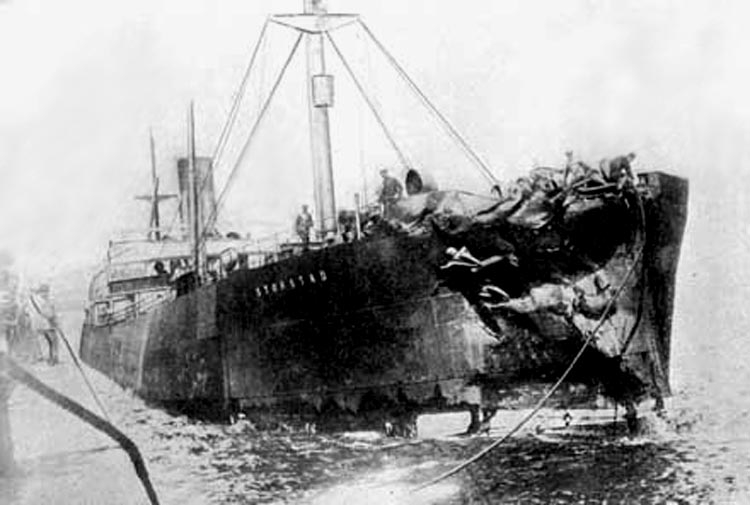
Amazing, but not surprising, a Norwegian inquiry which had no authority, conducted at the Norwegian Consulate General in Montreal, who not unexpectedly found hat the Norwegians would exonerate the Storstad as well as her Captain Thomas Andersen, who was asleep at the time of the collision, thus technically it may not have been his fault, but when it comes to chain of command, fault always rests with the captain!
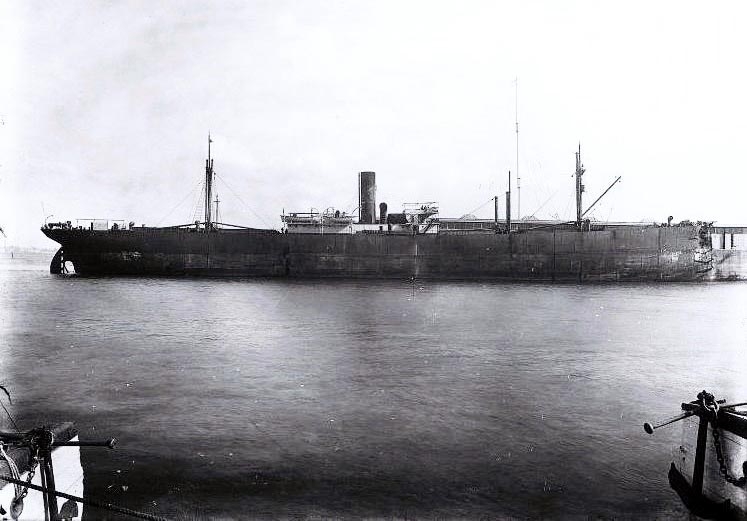
A
view of the SS Storstad with her damaged bow at
But despite the scale of the tragedy, the Empress of Ireland’s tragedy never achieved anything like the Titanic's prominence or enduring fascination. And yet even though the passenger deaths outnumbered the count of the Titanic, yet those on the Empress were not given as much attention. We may ask why? But the answer is very simple, for the Titanic was owned by what was known as a luxury shipping Company and she had many prominent, super rich people on board, many of who passed away when she sank. Whilst the just 14,000 GRT Empress of Ireland mostly transported middle-class citizens with only a small number of more affluent ones in its First Class!
But with the outbreak of the First World War,
the disaster quickly faded from memory. Captain Henry Kendall and
the Captain of the SS Storstad Thomas Andersen soon served during
World War I, and amazingly the two of them were torpedoed in
their respective ships with both men surviving. But the Storstad
certainly did not, for Canadian Pacific had sold her for $175.000
and she was ultimately torpedoed and sunk on March 8, 1917
by a U-Boat the U-62, near the coast of
Captain Henry Kendall never returned to sea
after the war and he passed away in
View
and excellent 6.03 minute YouTube presentation of the Empress of
Ireland Tragedy
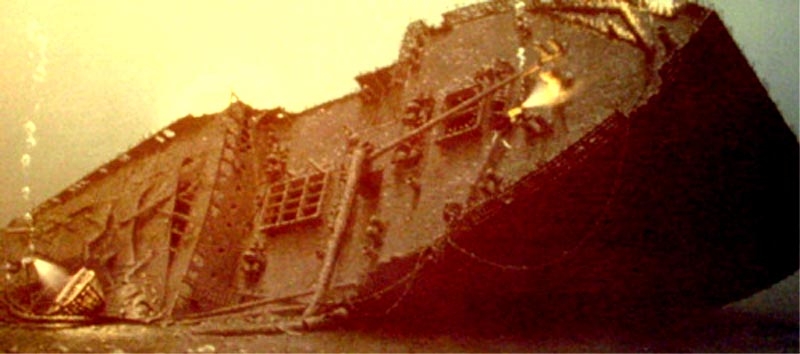
Two
divers seen on what was the fore part of her superstructure and
the bow
Finally on April 30, 1998, the remains of the
Empress of Ireland was declared a Historic Site by the Quebec
Provincial Government. The shipwreck became the first underwater
Heritage site in
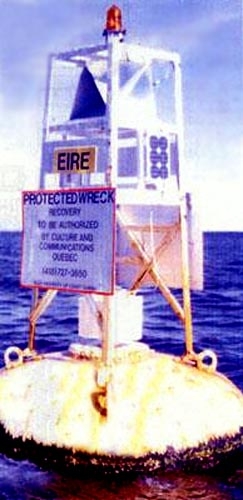
The
wreck marker for the Empress of Ireland on the St. Lawrence
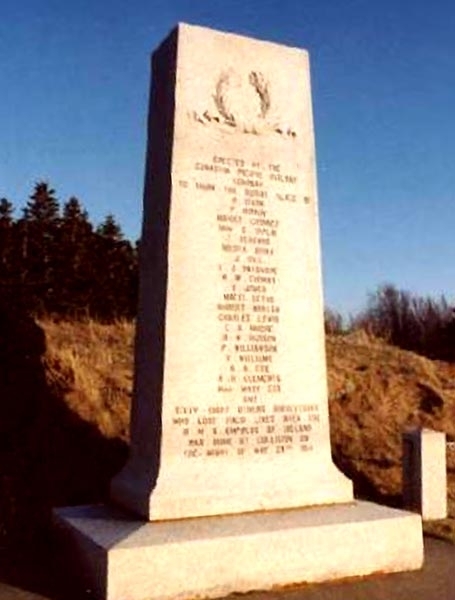
The
Memorial erected by the CPR on the south bank of the
Edith Grace Hanagan was born in
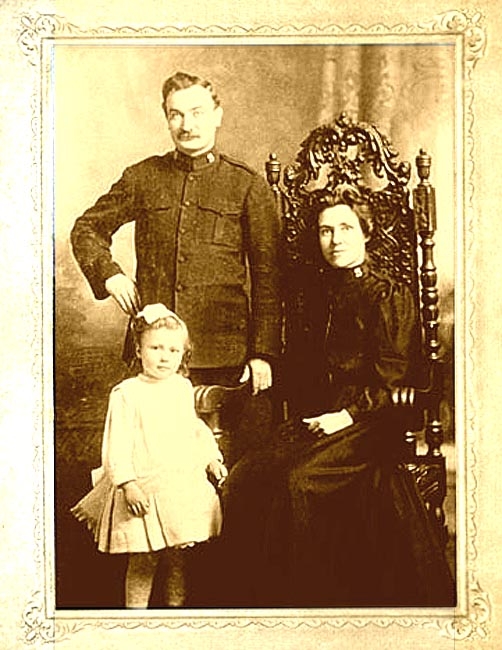
Here
we see young Grace at the foot of her Mother Edith Emily and her
Father Bandleader Edward James Hanagan
On May 28, 1914, Grace's father was taking her
and her mother along with 164 other Salvation Army members
travelling on board the Empress of Ireland from  the
water will come in.”
the
water will come in.”
Grace and her parents were woken up by a noise that sounded like “a firecracker” according to Grace. They did not know what it was until her Father said that it was the pilot coming for the mail, thus they just relaxed and remained in bed. But then suddenly the door opened and somebody came into their cabin and told them to get out fast because the Empress of Ireland was sinking. So Grace and her parents got out of bed and ran out of their cabin down the hallway and they finally got out on deck. Once deck they found Ensign Ernest Pugmire, and Mr. Hanagan asked for Pugmire's overcoat in order that he could wrap it around seven year old Grace, so he gave it to them. They were close to some stairs, but the ship was listing so quickly that they could hardly climb. Thus they sat on the high part of the railing of the stairs along with the Evans family until the ship went down and the three of them were thrown into the water. Grace went under the water twice until she finally got a hold of a piece of wreckage. She then lost sight of her parents in the panicking crowd in the water. A few minutes later Grace saw a couple of lifeboats and she called for help. One crowded boat came over and the people in the lifeboat pulled Grace in. In the lifeboat, Grace lost consciousness, and woke up in a bed on board the Storstad, and she asked for her mother.
Grace
Hanagan Martyn is seen here in her latter years during her TV
statement -
Grace was then taken to a Hospital in
Watch
Grace’s short YouTube (TV) statement regarding her being
saved HERE
Edith Grace Hanagan Martyn was the very last
survivor of the sinking of the Empress of Ireland, but she passed
away on May 15, 1995 in St. Catharine’s,
Remembering
a Magnificent Classic Canadian Pacific Liner
That
was so tragically struck down in the Prime of her Life!
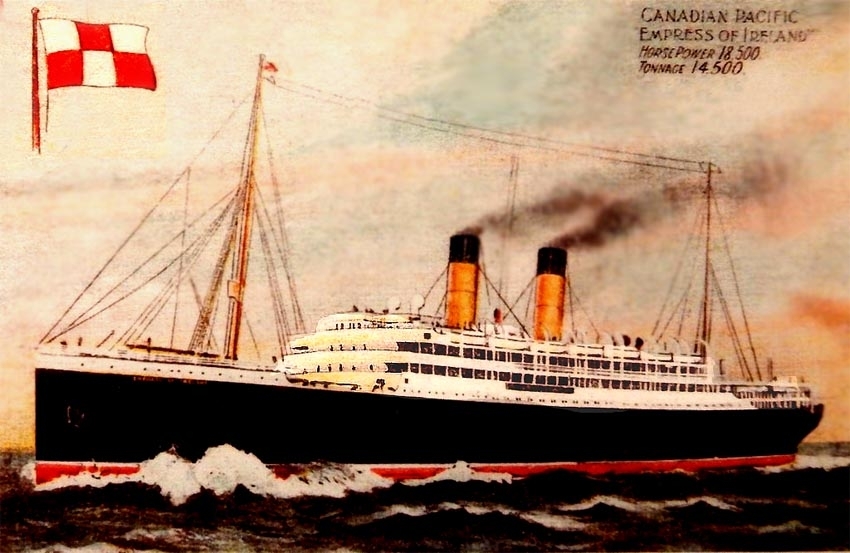
Return
to Page One “Empress of
I watched them come, I watched them go and I watched them
die.”